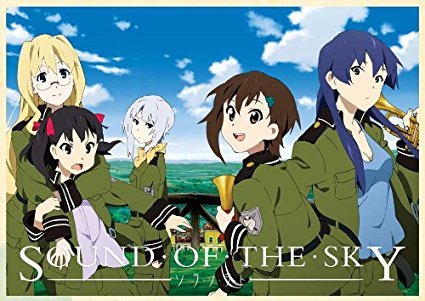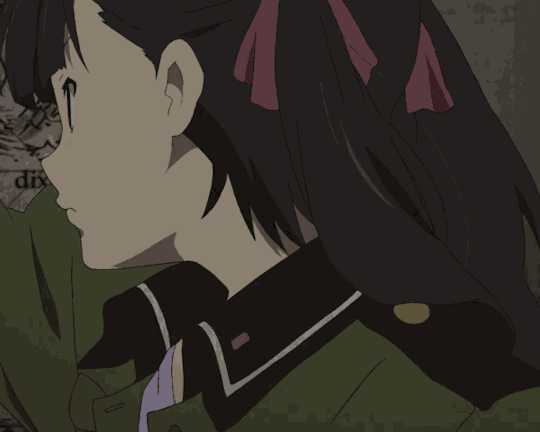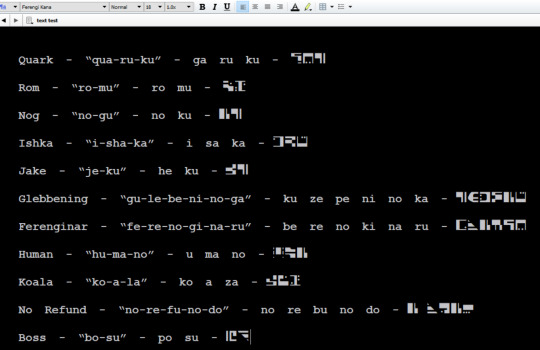#ソ・ラ・ノ・ヲ・ト
Text

Original title: So-Ra-No-Wo-To | ソ・ラ・ノ・ヲ・ト.
#tv shows#tv series#polls#sound of the sky#aoi yuki#kobayashi yu#ishizuka unsho#2010s series#japanese series#have you seen this series poll
25 notes
·
View notes
Text
0 1 2 3 4 5 6 7 8 9 A B C D E F G H I J K L M N O P Q R S T U V W X Y Z А Б В Г Д Е Ж З И Й К Л М Н О П Р С Т У Ф Х Ц Ч Ш Щ Ъ Ы Ь Э Ю Я Ѐ Ё Ђ Ѓ Є Ѕ Ї Ј Љ Њ Ћ Ќ Ѝ Ў Џ Ѡ Ѣ Ѥ Ա Բ Գ Դ Ե Զ Է Ը Թ Ժ Ի Լ Խ Ծ Կ Հ Ձ Ղ Ճ Մ Յ Ն Շ Ո Չ Պ Ջ Ռ Ս Վ Տ Ր Ց Ւ Փ Ք Օ Ֆ ֏ ᚠ ᚡ ᚢ ᚣ ᚤ ᚥ ᚦ ᚧ ᚨ ᚩ ᚪ ᚫ ᚬ ᚭ ᚮ ᚯ ᚰ ᚱ ᚲ ᚳ ᚴ ᚵ ᚶ ᚷ ᚸ ᚹ ᚺ ᚻ ᚼ ᚽ ᚾ ᚿ ᛀ ᛁ ᛂ ᛃ ᛄ ᛅ ᛆ ᛇ ᛈ ᛉ ᛊ ᛋ ᛌ ᛍ ᛎ ᛏ ᛐ ᛑ ᛒ ᛓ ᛔ ᛕ ᛖ ᛗ ᛘ ᛙ ᛚ ᛛ ᛜ ᛝ ᛞ ᛟ ᛠ ᛡ ᛢ ᛣ ᛤ ᛥ ᛦ ᛧ ᛨ ᛩ ᛪ ᛫ ᛬ ᛭ ᛮ ᛯ ᛰ Ⰰ Ⰱ Ⰲ Ⰳ Ⰴ Ⰵ Ⰶ Ⰷ Ⰸ Ⰹ Ⰺ Ⰻ Ⰼ Ⰽ Ⰾ Ⰿ Ⱀ Ⱁ Ⱂ Ⱃ Ⱄ Ⱅ Ⱆ Ⱇ Ⱈ Ⱉ Ⱊ Ⱋ Ⱌ Ⱍ Ⱎ Ⱏ Ⱐ Ⱑ Ⱒ Ⱓ Ⱔ Ⱕ Ⱖ Ⱗ Ⱘ Ⱙ Ⱚ Ⱛ Ⱜ Ⱝ Ⱞ Ⴀ Ⴁ Ⴂ Ⴃ Ⴄ Ⴅ Ⴆ Ⴇ Ⴈ Ⴉ ��� Ⴋ Ⴌ Ⴍ Ⴎ Ⴏ Ⴐ Ⴑ Ⴒ Ⴓ Ⴔ Ⴕ Ⴖ Ⴗ Ⴘ Ⴙ Ⴚ Ⴛ Ⴜ Ⴝ Ⴞ Ⴟ Ⴡ Ⴢ Ⴣ Ⴤ Ⴥ Ⴧ Ⴭ あ い う え お か が き ぎ く ぐ け げ こ ご さ ざ し じ す ず せ ぜ そ ぞ た だ ち ぢ つ づ て で と ど な に ぬ ね の は ば ぱ ひ び ぴ ふ ぶ ぷ へ べ ぺ ほ ぼ ぽ ま み む め も や ゆ よ ら り る れ ろ わ ゐ ゑ を ん ゔ ゞ ゟ ア イ ウ エ オ カ ガ キ ギ ク グ ケ ゲ コ ゴ サ ザ シ ジ ス ズ セ ゼ ソ ゾ タ ダ チ ヂ ツ ヅ テ デ ト ド ナ ニ ヌ ネ ノ ハ バ パ ヒ ビ ピ フ ブ プ ヘ ベ ペ ホ ボ ポ マ ミ ム メ モ ャ ヤ ユ ヨ ラ リ ル レ ロ ワ ヰ ヱ ヲ ン ヴ ヵ ヷ ヸ ヹ ヺ ㄅ ㄆ ㄇ ㄈ ㄉ ㄊ ㄋ ㄌ ㄍ ㄎ ㄏ ㄐ ㄑ ㄒ ㄓ ㄔ ㄕ ㄖ ㄗ ㄘ ㄙ ㄚ ㄛ ㄜ ㄝ ㄞ ㄟ ㄠ ㄡ ㄢ ㄣ ㄤ ㄥ ㄦ ㄧ ㄨ ㄩ ㄪ ㄫ ㄬ ㄭ ㆠ ㆡ ㆢ ㆣ ㆤ ㆥ ㆦ ㆧ ㆨ ㆩ ㆪ ㆫ ㆬ ㆭ ㆮ ㆯ ㆰ ㆱ ㆲ ㆳ 𐌰 𐌱 𐌲 𐌳 𐌴 𐌵 𐌶 𐌷 𐌸 𐌹 𐌺 𐌻 𐌼 𐌽 𐌾 𐌿 𐍀 𐍁 𐍂 𐍃 𐍄 𐍅 𐍆 𐍇 𐍈 𐍉 𐍊 𐐀 𐐁 𐐂 𐐃 𐐄 𐐅 𐐆 𐐇 𐐈 𐐉 𐐊 𐐋 𐐌 𐐍 𐐎 𐐏 𐐐 𐐑 𐐒 𐐓 𐐔 𐐕 𐐖 𐐗 𐐘 𐐙 𐐚 𐐛 𐐜 𐐝 𐐞 𐐟 𐐠 𐐡 𐐢 𐐣 𐐤 𐐥 𐐦 𐐧 𛀁
idk just thought of the twitter bot that used code to assign every unicode symbol a meaning and thus created a hyper-compact writing system that could get a incredibly high amounts of info compressed into a short message. that counts as a megascript to me so all i'm doing is pondering the magic.
16 notes
·
View notes
Text
Shuko from Sound of the Sky
Today's AniAnimal is Shuko the Northern White-faced Owl from "Sound of the Sky".
今日のアニアニマルは『ソ・ラ・ノ・ヲ・ト』の アフリカオオコノハズク の シュコ です。
2 notes
·
View notes
Text
Hiragana and Katakana / ひらがな、カタカナ
There are 3 types of characters in Japanese - Hiragana, Katakana, and Kanji.
Hiragana(ひらがな) is the easiest to read, and every sentence can be written in it, just like alphabet in English, even if we don't know correct Kanji.
Katakana(カタカナ) is another version of Hiragana, used for the words from foreign countries. For example, we write "ケーキ"(from "cake" in English) or "パン"(from "pão" in Portuguese, which means "bread" in English) as both didn't originally exist in Japan.
Kanji was brought from China, of course, and were developed as Japanese characters. Each Kanji has each meaning, so it makes us easier to understand what it exactly means. For example, when we see "いし", we don't know what it means because we have many words of the same sound ;石(stone), 意思(intention), 医師(doctor), etc.
Japanese sentences are made up of a mixture of these three types of characters.
Hereunder you can see the list of Hiragana and Katakana.
基本ひらがな(Basic Hiragana)
-for keyboard input-
あ(A) い(I) う(U) え(E) お(O)
か(Ka) き(Ki) く(Ku) け(Ke) こ(Ko)
さ(Sa) し(Shi) す(Su) せ(Se) そ(So)
た(Ta) ち(Chi) つ(Tsu) て(Te) と(To)
な(Na) に(Ni) ぬ(Nu) ね(Ne) の(No)
は(Ha) ひ(Hi) ふ(Fu) へ(He) ほ(Ho)
ま(Ma) み(Mi) む(Mu) め(Me) も(Mo)
や(Ya) ゆ(Yu) よ(Yo)
ら(Ra) り(Ri) る(Ru) れ(Re) ろ(Ro)
わ(Wa) を(Wo)
ん(N)
As for pronunciation...
orange colored characters are sometimes different from the original sounds.(は may be pronounced "Wa", へ may be "E", and it depends on how to use the character in the sentence.)
Red colored ones are completely different.(を is always pronounced "o", not "wo".)
濁音(Daku-on)~濁点付き(With ゛ Dakuten)
が(Ga) ぎ(Gi) ぐ(Gu) げ(Ge) ご(Go)
ざ(Za) じ(Ji) ず(Zu) ぜ(Ze) ぞ(Zo)
だ(Da) ぢ(Di) づ(Du) で(De) ど(Do)
ば(Ba) び(Bi) ぶ(Bu) べ(Be) ぼ(Bo)
Pronunciation : ぢ="Dzi" or "Ji"
づ="Dzu" or "Zu"
半濁音(Han-dakuon)~半濁点付き(With ゜Han-
dakuten)
ぱ(Pa) ぴ(Pi) ぷ(Pu) ぺ(Pe) ぽ(Po)
拗音(You-on)
きゃ(Kya) きゅ(Kyu) きょ(Kyo)
ぎゃ(Gya) ぎゅ(Gyu) ぎょ(Gyo)
しゃ(Sha) しゅ(Shu) しょ(Sho)
じゃ(Ja) じゅ(Ju) じょ(Jo)
ちゃ(Cha) ちゅ(Chu) ちょ(Cho)
ぢゃ(Dya) ぢゅ(Dyu) ぢょ(Dyo)
にゃ(Nya) にゅ(Nyu) にょ(Nyo)
ひゃ(Hya) ひゅ(Hyu) ひょ(Hyo)
びゃ(Bya) びゅ(Byu) びょ(Byo)
ぴゃ(Pya) ぴゅ(Pyu) ぴょ(Pyo)
みゃ(Mya) みゅ(Myu) みょ(Myo)
りゃ(Rya) りゅ(Ryu) りょ(Ryo)
Pronunciation : ぢゃ= "Dza" or "Ja"
ぢゅ="Dzu" or "Ju"
ぢょ="Dzo" or "Jo"
促音(Soku-on)= っ 小さい「つ」(Small“tsu”)
There is no romaji for single small “っ”,
because we add one more next character,
like き���て=Kitte , or はっぱ=Happa.
基本カタカナ(Basic Katakana)
Pronunciation is completely same as Hiragana and please read above in detail.
ア(A) イ(I) ウ(U) エ(E) オ(O)
カ(Ka) キ(Ki) ク(Ku) ケ(Ke) コ(Ko)
サ(Sa) シ(Shi) ス(Su) セ(Se) ソ(So)
タ(Ta) チ(Chi) ツ(Tsu) テ(Te) ト(To)
ナ(Na) ニ(Ni) ヌ(Nu) ネ(Ne) ノ(No)
ハ(Ha) ヒ(Hi) フ(Fu) ヘ(He) ホ(Ho)
マ(Ma) ミ(Mi) ム(Mu) メ(Me) モ(Mo)
ヤ(Ya) ユ(Yu) ヨ(Yo)
ラ(Ra) リ(Ri) ル(Ru) レ(Re) ロ(Ro)
ワ(Wa) ヲ(Wo)
ン(N)
濁音(Daku-on)~濁点付き(With ゛ Dakuten)
ガ(Ga) ギ(Gi) グ(Gu) ゲ(Ge) ゴ(Go)
ザ(Za) ジ(Ji) ズ(Zu) ゼ(Ze) ゾ(Zo)
ダ(Da) ヂ(Di) ヅ(Du) デ(De) ド(Do)
バ(Ba) ビ(Bi) ブ(Bu) ベ(Be) ボ(Bo)
半濁音(Han-dakuon)~半濁点付き(With ゜
Han-dakuten)
パ(Pa) ピ(Pi) プ(Pu) ペ(Pe) ポ(Po)
拗音(You-on)
キャ(Kya) キュ(Kyu) キョ(Kyo)
ギャ(Gya) ギュ(Gyu) ギョ(Gyo)
シャ(Sha) シュ(Shu) ショ(Sho)
ジャ(Ja) ジュ(Ju) ジョ(Jo)
チャ(Cha) チュ(Chu) チョ(Cho)
ヂャ(Dya) ヂュ(Dyu) ヂョ(Dyo)
ニャ(Nya) ニュ(Nyu) ニョ(Nyo)
ヒャ(Hya) ヒュ(Hyu) ヒョ(Hyo)
ビャ(Bya) ビュ(Byu) ビョ(Byo)
ピャ(Pya) ピュ(Pyu) ピョ(Pyo)
ミャ(Mya) ミュ(Myu) ミョ(Myo)
リャ(Rya) リュ(Ryu) リョ(Ryo)
促音(Soku-on)= ッ 小さい「ツ」(Small “tsu”)
0 notes
Text
I started learning katakana, which is used for foreign words, names, and onomatopoeia. Just like hiragana, katakana has 46 characters. Here’s the complete list with their pronunciations:
Character Pronunciation
ア a
イ i
ウ u
エ e
オ o
カ ka
キ ki
ク ku
ケ ke
コ ko
サ sa
シ shi
ス su
セ se
ソ so
タ ta
チ chi
ツ tsu
テ te
ト to
ナ na
ニ ni
ヌ nu
ネ ne
ノ no
ハ ha
ヒ hi
フ fu
ヘ he
ホ ho
マ ma
ミ mi
ム mu
メ me
モ mo
ヤ ya
ユ yu
ヨ yo
ラ ra
リ ri
ル ru
レ re
ロ ro
ワ wa
ヲ wo
ン n
I’ve been practicing these characters using flashcards and writing them out.
I’m getting the hang of it and it’s pretty fun seeing how different words are written in katakana. More updates coming soon as I dive into kanji for my final project!
0 notes
Photo



Added settei for Sora no Woto, scanned by Maxumym.
#sora no woto#sora no oto#sound of the sky#ソ・ラ・ノ・ヲ・ト#settei#model sheets#production artwork#anime#character design#animation#line art#character sheet
22 notes
·
View notes
Photo



Wuhhh??
#sound of the sky#so ra no wo to#ソ・ラ・ノ・ヲ・ト#noël kannagi#kannagi noel#cute#anime#anime gif#my gif: sound of the sky
34 notes
·
View notes
Photo

Sora no woto’s 1121st platoon is officially part of @argumate‘s anti-anime defense force
24 notes
·
View notes
Text
ソ・ラ・ノ・ヲ・ト
Sound of the Sky is an original military/slice of life drama-comedy. It was directed by Mamoru Kanbe, written by Hiroyuki Yoshino, scored by Michiru Ooshima, and animated by A-1 Pictures for the winter 2010 season. Private Kanata Sorami joins the military as a bugler and is stationed in the city of Seize with the 1121st Platoon.

Throughout the normal run of the anime there are exactly zero airplanes, or indeed flying machines of any kind. The world itself is post-apocalyptic where technology has regressed to roughly that of the 1930s or 40s. The heavy machinery of choice in this world are the tanks, which are quadrupedal and based off a highly-advanced pre-war design.
For its complete lack of airplanes, especially in a setting that seems so ripe for them, Sound of the Sky earns itself 0 out of 5 Airplanes.

But wait, I said “normal run.” That means there must be more to it. In addition to the twelve episode series there were two OVAs released, episodes 7.5 and 13. We can safely ignore 7.5 to focus entirely on 13.
Kanata realizes that she doesn’t know what her dream for the future is, and goes around asking the other cast members what their dreams are, for reference. The dream that we are interested in is that of Lieutenant Rio Kazumiya. Through her we learn that aviation is one of the lost technologies and, while she has built a hot air balloon that she lets Kanata ride in, her real dream is reinventing the airplane and using it to explore beyond the wastelands in search of a way to keep the world from ending.
In the end, the OVA gets a Participation Ribbon, and Lieutenant Kazumiya gets a Gold Star.
#ソ・ラ・ノ・ヲ・ト#ソラノヲト#sound of the sky#Mamoru Kanbe#Hiroyuki Yoshino#Michiru Ooshima#A-1 Pictures#show#void#ova#participation ribbon#gold star#anime review#airplane#ww2#wwii#takamikazuchi#kanata sorami#rio kazumiya#tank#hot air balloon
7 notes
·
View notes
Photo

evil_eye.gif
Source:
ソ・ラ・ノ・ヲ・ト
Sound of the Sky
20 notes
·
View notes
Photo

244 notes
·
View notes
Text
Languages of the world
Ainu (アイヌ・イタㇰ/Ainu-itak)
Basic facts
Number of native speakers: 5
Spoken in: Japan, Russia
Script: Katakana, 81 letters/Latin, 81 letters
Grammatical cases: 6
Linguistic typology: agglutinative, SOV
Language family: Ainu
Number of dialects: 3
History
1994 - the last speaker of one of the dialects dies
2008 - the Japanese government recognizes Ainu as an indigenous language
Writing system and pronunciation
These are the letters that make up the Katakana script: ア イ ウ エ オ カ キ ク ケ コ ㇰ サ シ ス セ ソ ㇲ タ ツ゚ テ ト ツ チ ャ チ ツ チャ チ ツ セ゚ チョ ナ ニ ヌ ネ ノ ㇴ/ン ハ ヒ フ ヘ ホ ㇵ ㇶ ㇷ ㇸ ㇹ パ ピ プ ペ ポ ㇷ゚ マ ミ ム メ モ ㇺ ヤ ユ イェ ヨ ラ リ ル レ ロ ㇻ ㇼㇽ ㇾ ㇿ ㇽ ワ ウィ/ヰ ウェ/ヱ ウォ/ヲ.
These are the letters that make up the Latin script: a c e h i k m n o p r s t u y w.
There are few consonant clusters, but when one appears, it is written using the syllable character followed by the character for the single consonant. For example, ikka is イㇰカ (i-k-ka).
Ainu has a pitch accent system used in words containing affixes. The high pitch is placed on the first syllable of the stem if it is long or on the second syllable if the former is short.
Grammar
Nouns have two genders (masculine and feminine), two numbers (singular and plural), and six cases (dative, instrumental, comitative, locative, allative, and ablative). However, these are not marked directly on the noun, but using other words that follow them.
Ainu uses postpositions. Adverbs are formed adding suffixes to adjectives.
Verbs are conjugated for tense, aspect, person, number, case, and valency.
Dialects
There used to be three dialects: Hokkaido, Sakhalin, and Kuril. The only one that survives is Hokkaido Ainu, with which the latter two were not mutually intelligible. They differed in phonology and lexicon.
118 notes
·
View notes
Text
What did I do with my Friday night, you may ask?
Half-assed a Ferengi katakana font, is what. Yeah, I'm what you'd call...pretty cool.

Deets below:
So it turns out the phonemes for the Ferengi character set (ganked from LCARS47.com) map fairly well onto katakana? With some notable exceptions. A lot of phonemes map 1:1 very nicely, but there are spots where Ferengi sounds mush together (ta/da, for example) where the kana make them distinct タダ (ta and da respectively).
There are also sounds that aren't present in Japanese that are distinct in the Ferengi that necessitated some counterintuitive mapping. All the Ferengi l- sounds map onto the z- dakuon, for instance. Ferengi z-sounds already lump into the s-/z-/sh- group, which left the z- dakuon free.
So, Leeta would be リタ ri ta in actual katakana. But to type her name in Ferengi, you have to spell it ジタ (ji ta) to give you "li ta".
For another example, to spell Garak: ガラク ga ra ku. But k- and g- sounds are grouped in Ferengi, so instead it's spelled ka ra ku.
And that left the g- dakuon free to use for the q- sounds that don't exist in katakana, so Quark, in katakana, would need to be クワルク ku wa ru ku. But in this Ferengi font it's spelled ga ru ku, which looks a lot closer to English Garak, doesn't it? ¯\_(ツ)_/¯
Ferengi doesn't appear to have terminal consonants going by the chart, so sounding out words feels eerily familiar to spelling in katakana. Maybe they clip off the vowel at the end, ~desu~ style.
Still, it's pretty fun to play with as an English cipher or for names and decorative nonsense. Here's a screenshot of my mucking around. From left to right: original word - Ferengi phonemes - what to type while in full-width katakana input mode - final result.

And here's the full mapping of phonemes to kana. You can see where I had to make some allowances. It's possible there's a different writing system that fits better, or a better way to map onto katakana, but this is as well as I can do with my "occasionally fucks around on duolingo" level of expertise, lol.
assigned phonemes: mapped kana:
a/ha a ア
i/hi i イ
u/hu u ウ
e/he e エ
o/ho o オ
ka/ga ka カ
ki/gi ki キ
ku/gu ku ク gu グ
ke/ge ke ケ
ko/go ko コ
sa/za/sha sa サ
si/zi/shi shi シ
su/zu/shu su ス
se/ze/she se セ
so/zo/sho so ソ
ta/da/tha ta タ da ダ
ti/di/thi hi ヒ
te/de/the te テ
tu/du/thu tsu ツ
to/do/tho to ト
na na ナ
ni ni ニ
ne ne ネ
nu nu ヌ
no no ノ n n
ma ma マ
mi mi ミ
me me メ
mu mu ム
mo mo モ
ya ya ヤ
ye yu ユ
yo yo ヨ
ra ra ラ
ri ri リ
re re レ
ru ru ル
ro ro ロ
wa wa ワ
wi do ド
we de デ
wo wo ヲ
pa/ba pa パ
pi/bi pi ピ
pe/be pe ペ
pu/bu pu プ
po/bo po ポ
fa/va ba バ
fi/vi bi ビ
fe/ve be ベ
fu/vu bu ブ
fo/vo bo ボ
cha/ja ha ハ
chi/ji chi チ
che/je he ヘ
chu/ju fu/hu フ
cho/jo ho ホ
la za ザ
li ji ジ
le ze ゼ
lu zu ズ
lo zo ゾ
qua/gwa ga ガ
qui/gwi gi ギ
que/gwe ge ゲ
quo/gwo go ゴ
#star trek#ds9#ferengi#free fonts#feel free to clone the font and make tweaks or different graphics or whatever#i just used the default brick set i didn't draw vector art or anything fancy#yes im avoiding working on other things how did you guess#all 5 people who might want this come get y'all food
108 notes
·
View notes

